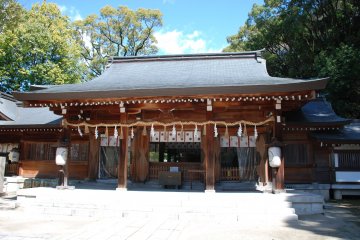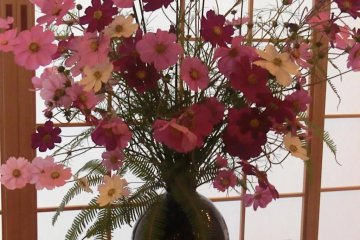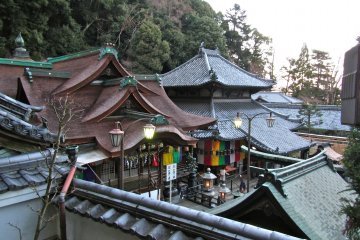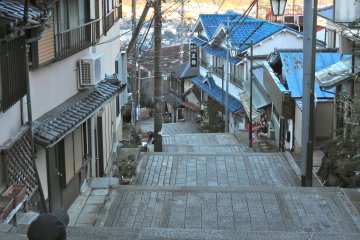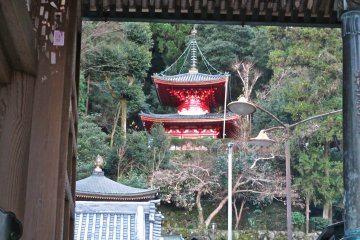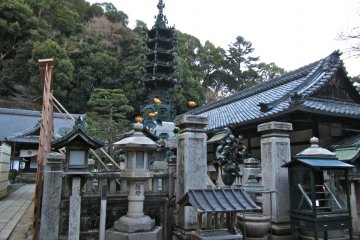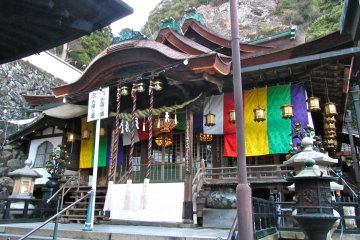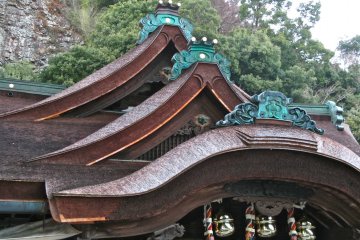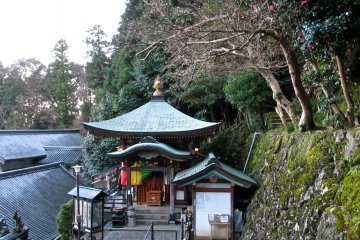“Go that way,” said an elderly man pointing to a narrow and rough looking stone stairway next to the broad lantern-lined stairs of Hozanji Temple. “Go that way! It’s better. You can see all of the Yamato Valley, Ikoma City and Nara City if you go that.” The old man entreated me again. His advice was some of the best I’ve ever received from a local. A rest area at the top of the stairs provided the perfect vantage point to snap some great shots of the sunset-lit scenery.
Hozanji Temple
Hozanji Temple halfway up Mt. Ikoma is a beautiful and pleasant place to visit and stroll through. It was established around 655 as a school to train Buddhist monks and to worship Mt. Ikoma and its resident deity. A shopping and entertainment district grew up on the slopes below the temple to serve those who came to worship and it endures to this day. Walking through the shops and streets of the town and through Hozanji's lantern-lined entrance path is an enjoyable and time consuming experience. One will find themselves looking for and finding multiple perfect camera angle from which to capture the character and feel of the area. The grounds of Hozanji offer a traditional feel that is undiluted by tourism and an interesting contrast of setting and architecture. Most of the buildings are the white stucco walled, black or dark wood trimmed structures with black ceramic kawara-tiled roofs typical of Japanese temples, but the Haiden-Do and Seiten-Do (prayer and altar halls) are constructed from brown wooden walls with bark or thrush roofs which are indicative of Shinto shrines. The red Taho-to pagoda on the slope above the central yard and the seated Buddha ensconced within an alcove of the cliff behind the Hon-Do (main hall) and Haiden-Do adds another very cool element. The pathway next to the main stairway and the rest area just south of Hozanji's main yard provide the best views of the Yamato Valley I've yet found.
The narrow streets of the town below Hozanji (some are actually wide stairways climbing Mt. Ikoma's slopes) and the shops and restaurants in the historic (or historic-looking buildings) and the uniquely Japanese feel they create command exploration. I was pressed for time and couldn't wander as much as I would have liked but my appetite for a return trip is whetted. My discovery of the Maharajahya Indonesian/Balien Restaurant will require a return visit for a meal and, perhaps, a future article.
Getting There
Hozanji Temple and the historic district are in Ikoma City at the top of the first of the two Mt. Ikoma cable cars. Get the Kintetsu Line to Ikoma Station, go out one of the 2nd floor gates on the south side of the station and walk along the walkways to the Torii-Mae Cable Car Station. The one way fare from Torii-Mae to Hozanji is ¥290. For better value pay the fare from Torii-Mae to Ikoma-Sanjo, the top of Mt. Ikoma, (¥360). This grants one the option of visiting the summit of Mt. Ikoma to take in the views while still allowing for a visit to Hozanji Temple and its sites.




